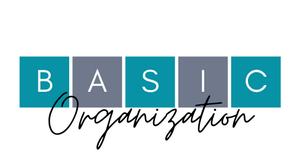5 Steps to Super Simple Paper Management
There are only 5 steps to super simple paper management.
I know, paper can pile up faster than dirty dishes. All those bills, receipts, records, statements can easily stress you out. Getting clear of the paper chaos in your life will save you time, money, energy and some say your sanity.
Follow these five simple steps to organize all your paper records.
Step #1. Toss what you can.
- After reconciling your monthly statements, you can toss any receipts for small purchases. You should keep receipts for large purchases for the life of the item.
- At the beginning of each calendar year, you can let go of all those monthly statements. Once you receive your yearly statement for an account the monthly statements can go. These types of paperwork include paycheck stubs, monthly credit cards, and mortgage statements, utility bills and brokerage and mutual fund reports.
Step # 2. Hang on to what you must.
- For tax purposes, you should hang on to any paperwork that supports your tax return, for seven years. After that time period, you can toss any supporting documents. Some of your supporting paperwork may include, W-2s and 1099s, year-end credit card statements, receipts for all deductible business expenses, charitable donations, child-care expenses, retirement account contributions, out-of-pocket medical expenses, mortgage-interest, and property-tax payments. Want a paper retention guide? Look here for a downloadable Paper Retention Schedule from Jazmine.
- After the seven-year tax period has lapsed, you only need to retain your actual tax return.
- You should keep receipts for major purchases and home improvements until you no longer own these items or you sell your home (and file taxes dealing with the sale). It is also important to keep the confirmation slips that show beneficiary designations and the purchase price of stocks, funds, and other investments.
Step #3. Give your papers a home.
- You don’t need fancy office furniture to get a handle on your paper piles. Designate a corner of a room or space in a closet to store your vital documents, so you will know where to find them when needed. You’ll need a filing cabinet or file boxes and file folders to complete your project.
- You’ll want to keep vital records such as birth and marriage certificates, insurance policies, deeds, and other permanent records in a fire-proof safe. Make sure that your heirs can access the safe if needed.
Step #4. Be systematic.
- You need a plan for processing all this paper. Have space where the paperwork that you need to act on will live until you are finished with it. But, once finished, the key to keeping up your system will be to file or toss each piece of paper. Don’t pile, act!
- A simple file system will work for most people. Have a folder for tax-related materials, credit card statements, financial statements, utility bills, etc. Taking the time to set up a filing system will save you time in the long run.
Step #5. Tackle the backlog.
- Once you have a system in place, you’ll need to deal with your accumulation. This can be done slowly, so you don’t get overwhelmed. Sort through and make decisions on an inch or two of a pile each day and the backlog will slowly disappear.
- Soon you’ll find that your system is saving you time, money, and frustration. You’ll love the peace of mind that you have created for yourself.
Subscribe by email
Enter your email address to subscribe to this blog and receive notifications of new posts by email.
Janet Schiesl

Janet has been organizing since 2005. She is a Certified Professional Organizer and the owner of Basic Organization.
She loves using her background as a space planner to challenge her clients to look at their space differently. She leads the team in large projects and works one-on-one with clients to help the process move quickly and comfortably. Call her crazy, but she loves to work with paper, to purge what is not needed and to create filing systems that work for each individual client.
Janet is a Past Board Member of the National Association of Productivity and Organizing Professionals and a Past President of the Washington DC Chapter of NAPO were she has been named Organizer of the Year and Volunteer of the Year.

Janet Schiesl
Janet has been organizing since 2005. She is a Certified Professional Organizer and the owner of Basic Organization.
She loves using her background as a space planner to challenge her clients to look at their space differently. She leads the team in large projects and works one-on-one with clients to help the process move quickly and comfortably. Call her crazy, but she loves to work with paper, to purge what is not needed and to create filing systems that work for each individual client.
Janet is a Past Board Member of the National Association of Productivity and Organizing Professionals and a Past President of the Washington DC Chapter of NAPO were she has been named Organizer of the Year and Volunteer of the Year.

Ah, the dreaded backlog! I don’t even want to talk about it.
Ha Ha!
Once you have a system in place, THEN tackle to backlog. Spot on advice! You have to figure out how to deal with the inflow which is coming every single day before you can get rid of the drawers of papers you’ve been accumulating for years.
I agree. Setting up a system first is key to success.
This is the thorn that so many of our clients deal with.
Thanks for breaking it up into the 5 steps.
Thanks Jonda. Paper is the hardest for people to organize, but once started, it’s easy to set up a structure and work within it.
These are the best 5 tips and they are spot on. I especially like the one about finding a home for your papers. So many people don’t know what to do with paper and this is an important step in the process.
Thanks Ronnie. I think a simple structure is best.
I decided to spend COVID tackling my backlog. My husband is very much a keeper, and it has been an exercise in compromise. He wants to keep more than you are suggesting, and I’ve helped to encourage him to shed more than he would have done if it were only him. At the end of the day, I think we have reached a good place, and I’m happy to say I have literally shredded tons of paper that is no longer in my space! I appreciate guidelines like these because so many people are anxious about what they can actually get rid of.
Thanks Seana. My husband is totally hands-off. I do all the paper – bill paying, filing, everything. It works for us, because I know that he would keep a lot more than I feel necessary.
Great tips! Paper filing is a big issue for my small business clients and my home organizing clients. I’m going to share this with them to remind them about the process. =) My favorite time of year is when I can go through my filing cabinets and get rid of the unwanted papers. The filing system stays the same but gets cleared out for the new year in December. Also, I don’t file every time there is something to file. I have a “to be filed” magnet bin attached to my filing cabinet. I place the papers there, and once a month, when I do bills, I file the papers in the folder. It works great and it only takes me 15 minutes to file all the papers at once. =) Yay!
I like your system. I also clean out my file cabinet once a year.
Great advice, and exactly how I approach things with my clients. You have to have a good, working system before you can plough through the backlog. Otherwise, you’re just rearranging deck chairs on the Titanic!
My organizing speciality is paper, but as much as I love it, I find that lately, for my own papers, I’d rather let things pile up and then tackle the backlog. During the pandemic, because I wasn’t seeing clients, I needed to scratch that itch of tackling lots of papers at once.
[Also, something weird happened above when I tried to post this, and it literally just posted my first name as a comment. Please delete when you can. Thanks!]
I think the backlog is what stops people from tackling this project. Paper is the only project that I suggest a system first, because you can start using it right away.